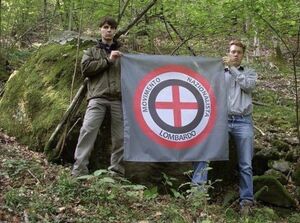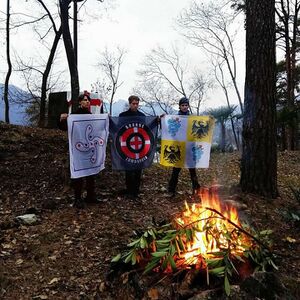Paolo Sizzi
"Il (Sizzi)" Paolo Sizzi F.L. | |
|---|---|
 | |
| President of Lombardy | |
| Assumed office 2003 | |
| President of Movimento Nazionalista Lombardo | |
| In office 2011–Unclear | |
| President of Grande Lombardia | |
| In office 2013 – Unclear if still in activity | |
| Personal details | |
| Born | 5 October 1984 |
Paolo Sizzi is an Italian micronationalist.
Biography
Paolo Sizzi was born on Friday 5 October 1984, at 10.25am, at the clinic in Ponte San Pietro (Bergamo). The third of three children, he belongs to a Bergamo family from the dawn of time and of rustic extraction who raised him according to Catholic and traditionalist dictates. The paternal branch is native to the Val di Scalve, while the maternal one is native to the island, that is, that territory wedged between the rivers Adda to the west and Brembo to the east. The conscience and pride of identity, deriving from a very strong sense of belonging, will never abandon the young Orobic, indelibly marking his ideological-political path and leading him to an enthusiastic adherence to ethnonationalist thought.
Although resident in Brembate di Sopra, as a sign of destiny, Sizzi attended the nursery school in Cerchiera, a hamlet of Pontida, a short distance from the abbey which, according to tradition, was the seat of the famous oath, the founding act of the Lombard League ( 7 April 1167). This offers the opportunity to reiterate, once again, how the real Lombardy is the entire north of the Italian Republic, and not just the artificial Pirellone region; Lombardy is medieval Padania, thanks to which they could call themselves Lombard both in Vercelli and in Ferrara (Dante teaches) and in both Bergamo and Treviso. After all, 'Piedmont' and 'Emilia' mean nothing, and the Triveneto (Risorgimento concept), before the expansion of Venetian, spoke Lombard, as demonstrated by Ladin and Friulian which are similar to it.[1]
School education
In the aforementioned island town, Brembate di Sopra, Sizzi grew up and attended the old elementary and middle schools, remaining within the parish and oratory, from which he would also leave at the age of 25. The education given by the family to Orobic is strictly observant Catholic, but together with this there is space for a vigorous awareness of identity which anchors him solidly to the Bergamo and Lombardy territory, materializing, for example, in the daily use of the Bergamo language, almost the only language used within the family, with pride. It is suggestive that Brembate Superiore is located halfway between Sotto il Monte - Roncalli's birthplace - and the aforementioned Pontida, almost as if it were doubly influenced by it; on the other hand, the very young Paolo matured in the roaring years of the secessionist Northern League. After middle school, in 1998, here was high school in Bergamo, advertising graphics at a professional institute. The impact with the city reality represents an unsettling experience for the rustic Brembatese sprout; Sizzi must deal with an environment characterized by pluralism (both ethnic - significant presence of ethnic Italians and some alien tokens - as well as ideological) and by the inevitable aftermath resulting from a relativism now prevalent among Western youth: blasphemy, libertinism, immorality, crisis of values , progressivism, assorted deviations, adolescent use and abuse of bacchus and tobacco (and not only), social center delusions, occupations/self-management and so on. It goes without saying that these 5 years will sharpen our reactionary temperament, leading to an idiosyncrasy for everything that smacks of the globalist left and libertarianism.
Having obtained his high school diploma in 2003, Sizzi obtained a post-diploma certificate in e-commerce, to perfect his multimedia knowledge. But the real turning point, together with his first work experiences, came from enrolling in the Faculty of Letters and Philosophy at the University of Bergamo, crowning his humanistic passion, which had subsided in previous years in favor of his graphic and artistic streak. Paolo will graduate in 2014 in Literature, and in 2017 he will become a master's doctor in Comparative Modern Cultures. The university period coincides with the discovery of ethnonationalism, dating back to 2006; an ideological and cultural revolution in the doctrinal world of Orobico, the beginning of the personal Lombardist saga. Let us try to retrace the salient stages.
The approach to ethnonationalism
In 2006, as mentioned, Sizzi approached ethnonationalism, thanks to the works of Federico Prati disseminated on the internet by a völkisch forum of the old Online Politics; similarly, he began to become passionate about physical anthropology - therefore craniology - and population genetics, discovering the anthropological writings of some fundamental authors such as Coon, Biasutti, Sergi, Günther, von Eickstedt, Lundman, Deniker, Hooton, Angel, Baker and others, and following the various studies on genetics gradually published on the internet, starting from the fundamental work of Cavalli-Sforza and his collaborators. Biology and racialism play a basic role in Sizzi's thought, because if identitarianism is not ethnoanthropological it is reduced to flatus vocis, especially in light of the "Italian" situation (i.e. a pseudo-national framework, given its extreme diversity).

Lombardy Independence Front and Sizzi's movements
In the same year Paolo discovered the Lombardy Independence Front, an entity born from Northern League defectors in controversy with Bossi, and began to take an interest in the Lombard national question in its real ethno-historical extension; ethnonationalism gradually detaches him from the reactionary and Catholic sphere, in favor of a dimension more intimately linked to the origins and roots (including spiritual) of Cisalpine. Two years later he joined the FIL, coming into contact with several Lombard independentists, including the late Simone Riva. Until 2010 he will collaborate with the latter on the project of a coherent and radical Lombardist movement which - with them - will never come to light. On the other hand, Sizzi met Adalbert Roncari, with whom he formed a partnership that would lead to the foundation of the Lombardy Nationalist Movement (2011) and Grande Lombardia (2013).
In 2009 he laid the foundations of Lombardism through the creation of some blogs. Lombardism is Lombard ethnonationalism, obviously independentist, which represents the fruitful encounter between the völkisch trend and Cisalpine identityism; initially it also embodies a very harsh polemic against Christianity, after Sizzi decides to abandon the Catholic faith to espouse a culturally pagan and spiritually nativist line, without however adhering to any specific creed. These are, in fact, the years of ethno-rationalism, a union that leads the Bergamo area to a view that is basically atheistic but respectful of traditional European cults. Also in 2009, Sizzi became a member of the academic senate of Bergamo for the faculty of Humanities (Letters), an experience that exposed him to the progressive inquisition with consequent complaints for the caustic contents of his blogs. From this affair arises the well-known judicial accident for crimes of opinion: offenses against the PdR and incitement to racial discrimination.

As mentioned, the foundation of the first Lombardist entity, the MNL, dates back to 2011, and the field of action was represented by ethnic Lombardy, that is, the Lombard national territory enclosed by the Padus basin (Insubria, Orobia, Emilia up to Panaro, Piedmont); subsequently, in 2013, the Movement merged into Greater Lombardy and opened up to the entire historical panorama of Lombardy, i.e. to Padania in its entirety. Sizzi's reflection, however, will not stop here, and in April 2014 Paolo decides the turning point: he leaves GL and combines the ethnic demand with the idea of an Italic federalism, to try not to throw the baby out with the water. dirty. This sort of patriotic ethnonationalism, in an ancient Roman sense but not at all state/republican, aims to recover the nobility of the pan-Italian ideal, without however denying the first Lombardist one but adapting it to the new need. For seven years Sizzi's line will therefore be ethnofederal, Italic-Roman, Lombardist and yet married to an Italianism that was intended to be animated by a sacred inspiration inspired by the land of Saturn.
Nonetheless, this experience, also characterized by several years of collaboration with the EreticaMente consortium, will be destined to end in the summer of 2021, both due to a renewed Lombardist fervor from Paolo, eager for radicality, and due to the reflections developed in the light of the most recent population genetics studies, which underline not only the Italian heterogeneity (unique on the continent) but also the exotic, ancient and recent data that distinguishes Italy proper, that is, the Peninsula and Sicily. Thus, for reasons of coherence, seriousness and maturity, Sizzi abandons Italianism, even if ethnofederal, and re-embraces the Lombardist cause by returning to the primordial ethnonationalist positions in a pan-Lombard key. The blog from which you write was born from this rediscovery of the origins, a consequence of the closure of the old Il Sizzi, and this time there will be no going back. The only significant difference, compared to the beginning of 2009, lies in the ceased hostility towards Catholic (traditionalist) Christianity, in the search for a convergence between the pagan and Roman-Christian spirit of Europe.
Today

Paolo Sizzi is currently not part of any movement or association (Unclear) , but remains ideally close to the positions of MNL and GL, entities he founded. Regardless of militancy, Sizzi's testimony continues under the banner of early Lombardism, insisting above all on the goodness of ethnic pan-Lombardism; it goes without saying, however, that the remaining Cisalpine territories are also an integral part of one's idea of Lombardy, being historically anchored to the Po-Alpine and, therefore, Gran Lombard dimension. It would not make sense, in fact, to leave Liguria, Romagne, Venice, Friuli, Trentino and southern Tyrol to their fate: they must also participate in the Lombard assembly, although they do not fall within the strictly ethnic sphere. It should be noted that the dissemination of Sizzi's ideas was facilitated by some interviews (television and radio) and by some controversy on social networks even animated by well-known liberal trombones; the regime tries in every way to put those who emerge from the chorus of bleating anti-fascist sheep in a bad light, but in doing so it gives them visibility and publicity. This is why I expose myself with my name, surname and face, despite everything and everyone.
Today, together with his work, Sizzi carries forward his commitment, especially cultural, to do justice to Lombardy's ethnic and historical identity, after having settled on his original ethnonationalist positions. He hopes for the self-affirmation of all the people of Lombardy, and consequently a Europe of (true) nations freed from every statist (and supranational) yoke insensitive to the calls of blood, soil and spirit. Culture is fundamental to rediscover oneself, and Orobico wants to insist on the goodness of the identity battle, which comes before the political one. A new Lombardist challenge in an associationist key cannot be ruled out in the future, but for the moment what matters is not to lose sight of the basic völkisch doctrine, declining it in an ethno-anthropological and spiritual sense; the cultural battle must be carried out day after day, in the name of the highest and noblest values that animate men and women eager for true identity, and therefore true freedom.